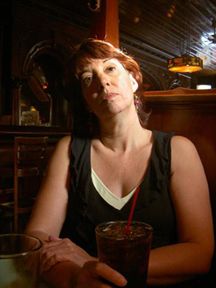It’s not easy at times to find
the multi-dexterous Susie Suraci.
She’s not a recluse, just a
busy girl. During the work-a-day week she’s in the admissions Department at
IPFW. Most evenings she’s at home in the city’s near south side, helping to
raise a family. Then there are evenings when she’s rehearsing or performing
with her husband, Rob Suraci, and their playmate John Minton with the Possum
Trot Orchestra.
Then there are the weekends
when, if not performing, you might catch her at her lakeside painting studio.
My lips are sealed, by request, as to the exact location of this retreat, but I
can reveal that it is in Noble County, reasonably primitive and quite possibly
an elemental ingredient in the creation of an artist’s colony. (I still can’t
figure out where she finds the time to compose her songs.)
Being in, or near, the water
isn’t just a therapeutic device for Suraci; it is more like a necessity. Born
and reared in Maryland, she’s an honest-to-goodness Malaclemys terrapin, i.e. a
turtle, the fearsome mascot of her alma mater, the University of Maryland, from
where she earned her degree in painting. (Some of her favorite influences were,
and are, the painters Larry Rivers, Richard Diebenkorn and Paul Klee.)
The idea of her migrating here
– to the home town of Mishekinoquah, the Miami chief Little Turtle – is a bit
of a stretch. Suffice it to say she’s got a foot on land and the other in
water, and we’ll dispense with the details.
Suraci’s current solo
exhibition, “Lake Trailer Paintings,” can be seen at the Dash-In, 814
Calhoun Street through September 7. Hours are Monday through Thursday from 7
a.m. to 4 p.m., Fridays from 7 to 7 and Saturdays from 10 until 4.
The show is built comfortably
in the confines of the coffee shop/restaurant, yet it, depending upon the time
of your visit, does or doesn’t do justice to her work regarding available lighting.
In the Dash-In show Suraci’s
focus is riveted upon a time and a subject when people placed trailers –
Airstreams and other less eye-pleasing, more iconic mobile homes – on lakefront
property as either weekend get-away enclaves or even permanent residences. She
does so in the manner of a documentary photographer attempting to capture a
bygone culture for posterity. And she does it with a serious purpose.
“I, well, just not
me,” Suraci says, “recognize that these offbeat retreats will likely
vanish relatively soon. The fact is that, as lake property continues to
increase in demand and investment value, many of the old lake trailers are
being hauled away in favor of more prestigious dwellings.”
Her painting style part
realistic, part impressionist – definitely conveys the essence of the modernist
architecture, but she leaves her work (perhaps purposely) without a human
quality. Her landscapes are populated by outdoor grills, tables, cars, trucks
and kids’ playthings, but never a glimpse of the human form. Trees, water and
lily pads remain in the surroundings, but the overall backdrop is absent of
people.
Sadly Suraci’s current lake
studio isn’t her first. Three years ago a vintage 1960s trailer which she had
patiently restored to pristine condition was completely destroyed in a fire
caused by an electrical short circuit.
Suraci confesses that she feels
a bit of an outsider with regards to the local art scene. “Maybe because
of my musical commitments that may be in conflict with my painting, I just
don’t feel connected with others in the painting scene.”
On the other hand the artist
has been a regular on the Fort Wayne art scene, having shown at Artlink, Castle
Gallery, a Muncie gallery and at the Fort Wayne Museum of Art in the Tri Kappa
Show. Some of the work in the Dash-In show came out of a 2004-2005 Individual
Artist Project grant she received from the Indiana Arts Commission.
Suraci’s musical gifts become
evident with even a cursory listen to her work. You can access a taste of The
Possum Trot Orchestra’s efforts at http://cdbaby.com/cd/possumtrot or take the
plunge as I did and spring for the entire CD (available at the Three Rivers
Food Co-op). According to liner notes and in the words of reviewers, “The
Possums forage across the American tradition, from folk, country and bluegrass
to blues, gospel and rock, with touches of pop, swing, ragtime – even
reggae.”
“And, I might add, they do it
authentically well.
The Dash-In show closes in less
than two weeks, so the pressure is on the reader to get to the ubiquitous
‘lake’ and catch Suraci’s captured cultural images.
 Submit Your Event
Submit Your Event
